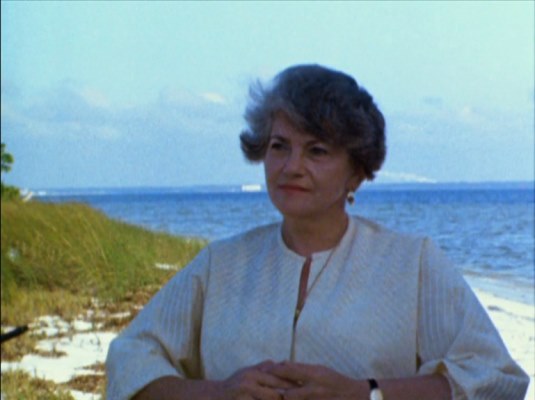Shoah: Four Sisters is a timely response to the persistence of Holocaust denial and the Polish government’s attempt to make it illegal to accuse that nation of complicity.
The late Claude Lanzmann changed Holocaust films completely when he released Shoah in 1985. For the first time on screen, the Nazi genocide was described through the personal experiences of survivors and eyewitnesses. Lanzmann began locating and interviewing survivors in 1973 and for 12 years visited the locations they described and edited 350 hours of raw footage into his nine-and-a-half-hour epic. He released edits with interviews that were longer than could fit into Shoah’s structure. The Criterion Collection’s DVD box set includes the additional documentaries: A Visitor from the Living (1999), Sobibór, October 14, 1943, 4 p.m. (2001), and Karski Report (2010). The Last of the Unjust (2013) followed separately.
Because Lanzmann’s original intent was to step-by-step document the progress of the Final Solution, female survivors were seen and heard only briefly. For example, about Auschwitz in Shoah, he wanted to interview Jewish prisoners ordered to work in the crematoria: “My decision to remain focused on the extermination process forced me to concentrate on the few surviving Sonderkommandos, who were exclusively male.” As seen at the 2017 New York Film Festival, almost a year before Lanzmann died, this film features four edited interviews with women as separate films that he packaged as The Four Sisters.
Baluty (named for a section of the city of Lodz, Poland) focuses on Paula Biren. Her full interview, more than two hours long, was conducted in the winter of 1978–1979 in Florida. Lanzmann wanted to film her because “Lodz ghetto witness accounts from survivors are quite rare.” He admired her frankness and “eye for detail” as a member of the ghetto’s Jewish women’s police, until its liquidation in 1944, a job she expected would keep her from deportation and help protect her family. Then after Auschwitz, she returned to “my country, Poland, speaking my mother tongue,” but found Poles were killing survivors. She left in 1946. Lanzmann asks her about the male ghetto policemen who wouldn’t talk to him because they still felt too guilty. She answers, “I just tried so hard to survive myself. Afterwards, nobody wanted to talk about it, so I shut up.”
The Hippocratic Oath with Ruth Elias from Ostravia, now in the Czech Republic, was conducted in 1979. The ironic title is taken from the climax of her harrowing account of her experiences. After three years hiding at a farm, her family was denounced and deported to Theresienstadt in 1942, where she married and stealthily communicated with her family. She got assigned as a nurse and managed to act cheerful and sing at meals to get extra food from the kitchen. Then in Auschwitz in the short-lived propaganda “family camp,” she hid her pregnancy during work details until Dr. Josef Mengele spotted her for a cruel experiment, carried out by his accomplice doctors. Forty years later, she could still sing.
The Merry Flea features Ada Lichtman from Krakow, Poland, filmed in the fall of 1979. Lanzmann poses her at a table with dolls, seemingly at first because she had apprenticed as a seamstress. After the Nazis’ invasion in 1939, her Polish neighbors joined in attacking Jews, even before the exterminations began. After being forced onto a crowded train and arriving in Sobibor, an officer picked her out to do laundry and cleaning, though this chapter’s title comes from the Germans’ ironic name for the filthy farmhouse where they were garrisoned. There, Lichtman noticed officers picked out pretty young women from German and Austrian convoys and kept them separate for socializing (Lanzmann doesn’t ask her to elaborate). She also witnessed officers immediately murdering Jewish children and taking away their dolls for cleaning before they were given to their German children, after new clothes were sewn. (These workshops portrayed in the recent Russian film Sobibor don’t show such children’s items.) Yet she suddenly remembers a song the women sang together to stave off death, “The Sun Will Shine on Me.”
In Noah’s Ark, Hannah Marton from Cluj (now in Romania) was interviewed on October 10–11, 1979, in her Jerusalem apartment. Her memories are aided by a precise journal kept by her husband. Lanzmann hones in on the controversial train of Jews in which they traveled out of occupied Hungary in 1944, as covered in the documentary Killing Kasztner: The Jew Who Dealt with Nazis (2008). Lanzmann gets aggressive when she reads out loud her husband’s specific notes, namely the characteristics of the Jews their hometown friend Rudolf Kasztner selected for the freedom train after some payment to Nazis: by politics (with a priority for Zionists like Marton and her husband), nationality, profession, religious connection, and military service. Lanzmann insists that wealthy Jews were able to pay their way for what he calls “Noah’s Ark.” But Marton defends the more than 1,600 passengers as a cross-section of the Jewish community. Even with Lanzmann’s emphasis on how this train was a stark anomaly, the journey, as factually documented in the journal, is suspensefully harrowing, with stops and changes in the Nazis’ requirements that forced some passengers off.
In 1996, the United States Holocaust Memorial Museum, in Washington, DC, purchased all of Lanzmann’s material and compiled excerpts in SHOAH: The Unseen Interviews (2012). The Claude Lanzmann Shoah Collection, shared with Yad Vashem, Israel’s Holocaust memorial, has more than 220 hours of tapes, including 185 hours of interview outtakes and 35 hours of location filming. More than 85 percent is accessible to the public and researchers as the museum staff completes its reconstruction and preservation. These full unedited interviews are available in the collection as outtakes.

















Leave A Comment